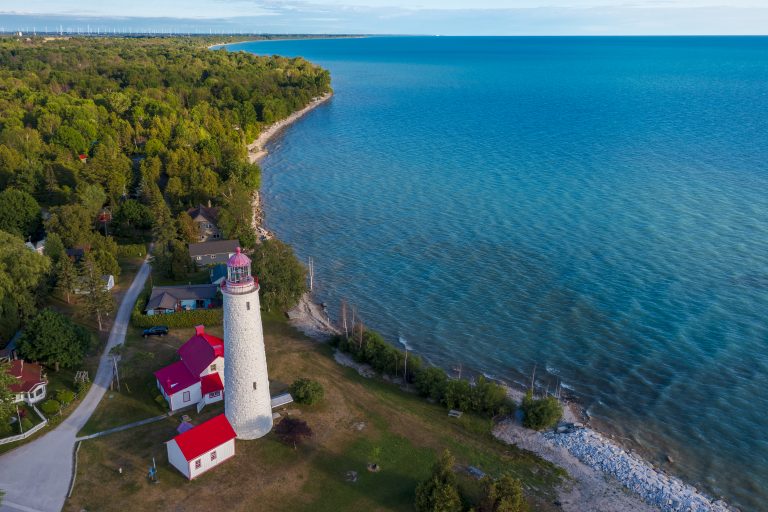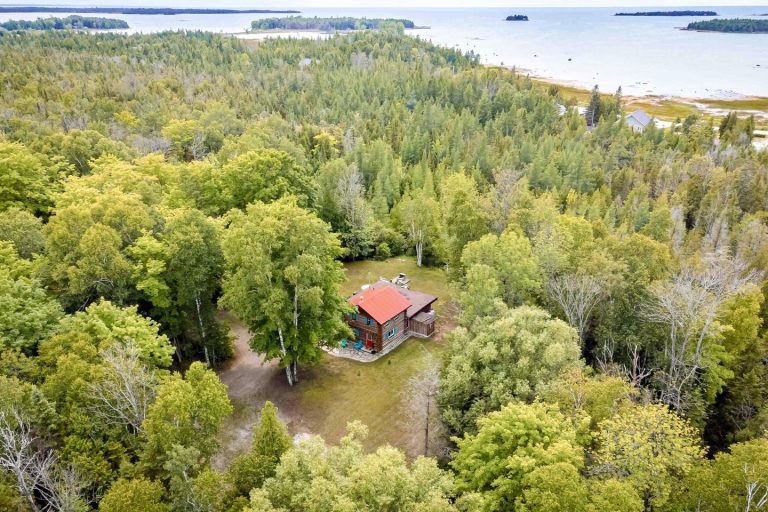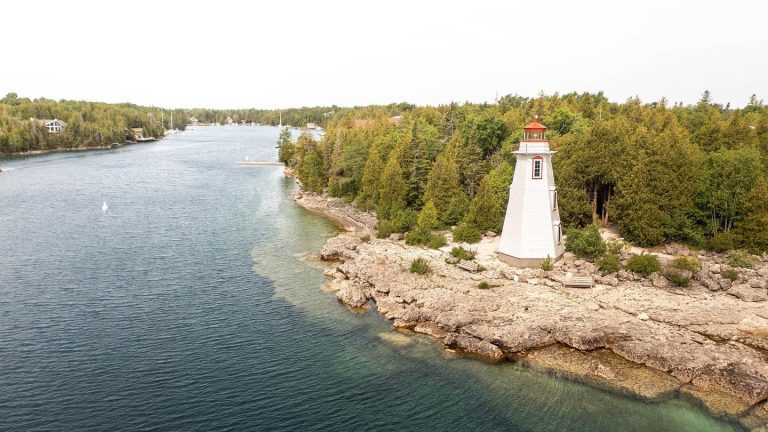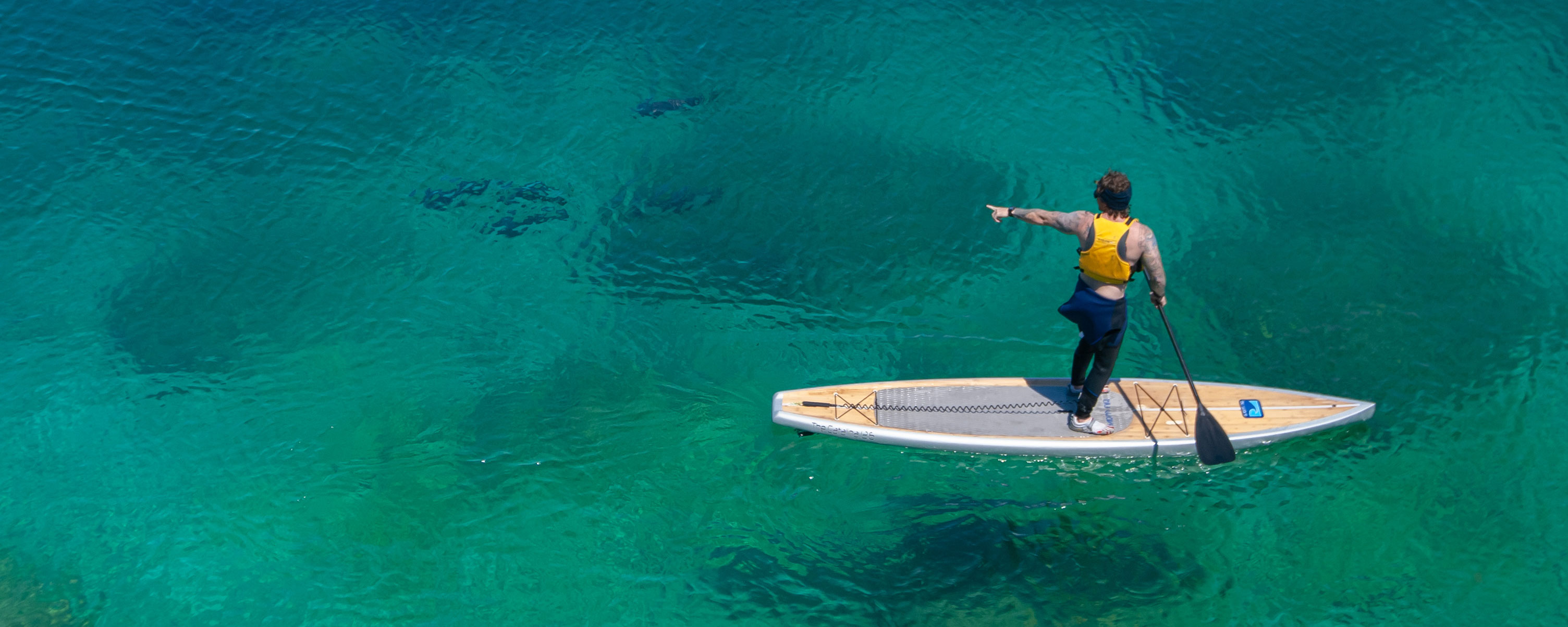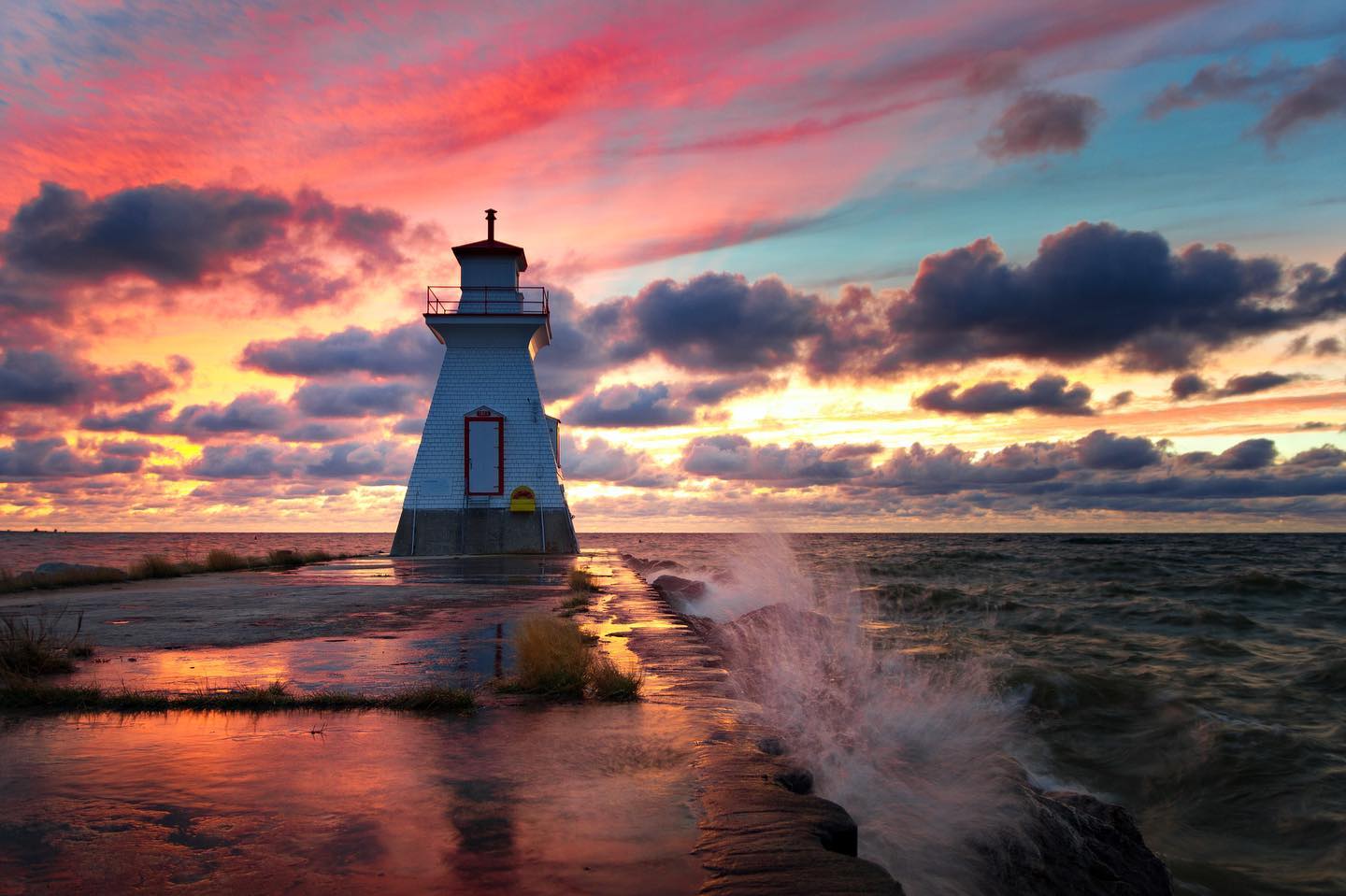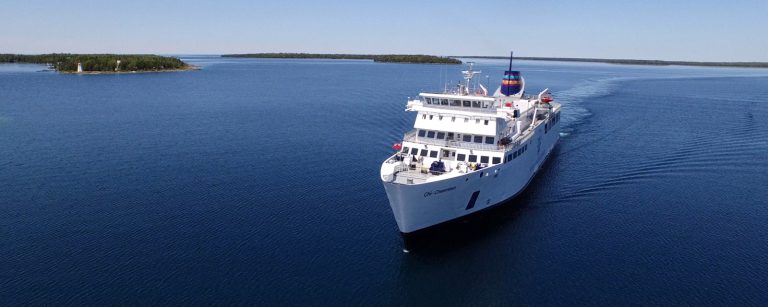Lighthouses to Brighten Your Day in Bruce County
Standing steadfast on the shoreline, travellers will find 14 lighthouses in Bruce County. Scattered across the region, each lighthouse features unique tales from long ago as they stand to commemorate the vast history of the Great Lakes. Stories of bravery, some with a hint of romance and the odd mysterious haunting, each lighthouse is unique and worth paying a visit to!
Point Clark Lighthouse National Historic Site
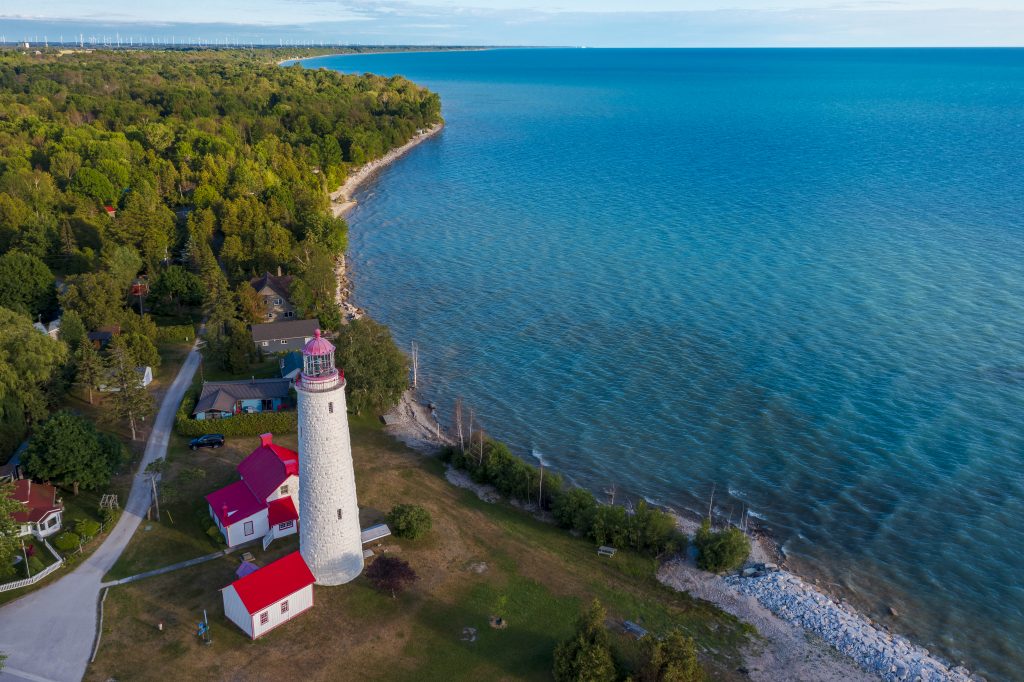
Built between 1855 and 1859, the Point Clark Lighthouse was built to warn sailors about the shallow waters approximately three kilometres from shore. It stands 87 feet in height and is constructed of limestone. Topped with a 12-sided lantern and a bronze lion head at each angle, Point Clark Lighthouse is one of the six Imperial Tower style lighthouses built in the region. This is a style not normally seen in other parts of Canada!
It was acquired by Parks Canada in 1967 to commemorate the rich marine heritage of the Great Lakes. To this day, Point Clark Lighthouse still operates though the lighthouse keeper’s dwelling has been transformed into a museum run by the Township of Huron-Kinloss. While the lighthouse isn’t open during the winter, you can still enjoy the views with the Point Clark Lighthouse webcam!
Things to Do in Point Clark
If you’re an experienced paddler, bring along your canoe or kayak and explore the waters around the lighthouse. The beach is always calling those who are more inclined to relax and soak up the summer sun!
Head into the interior of Bruce County and you’ll find the tiny town of Ripley. Here you can indulge in some fantastic eats at the FIG Studio Kitchen like their Metzger’s maple brisket sliders and smoked duck breast. Close by you’ll find the Bruce Botanical Food Gardens where you can walk through and admire the 250 unique varieties of growing food while learning about issues surrounding sustainable food production and food security.
There are also a number of great hiking trails close by where you can stretch your legs and explore. The Great Lakes Waterfront Trail follows the shoreline of the Great Lakes and passes right by the lighthouse. Close by is the Deer Run Nature Trail which takes you through an Environmentally Sensitive Area in the Clark’s Creek Floodplain, protecting various vegetation including wild red raspberry, white ash, sugar maples and more. Lastly, there’s the Apple Rail Trail that meanders past the Bruce Botanical Food Gardens and merges with the former CN Rail route.
Of course, Kincardine is just 20 minutes north along the shore so head there for more things to do!
Kincardine Lighthouse and Museum
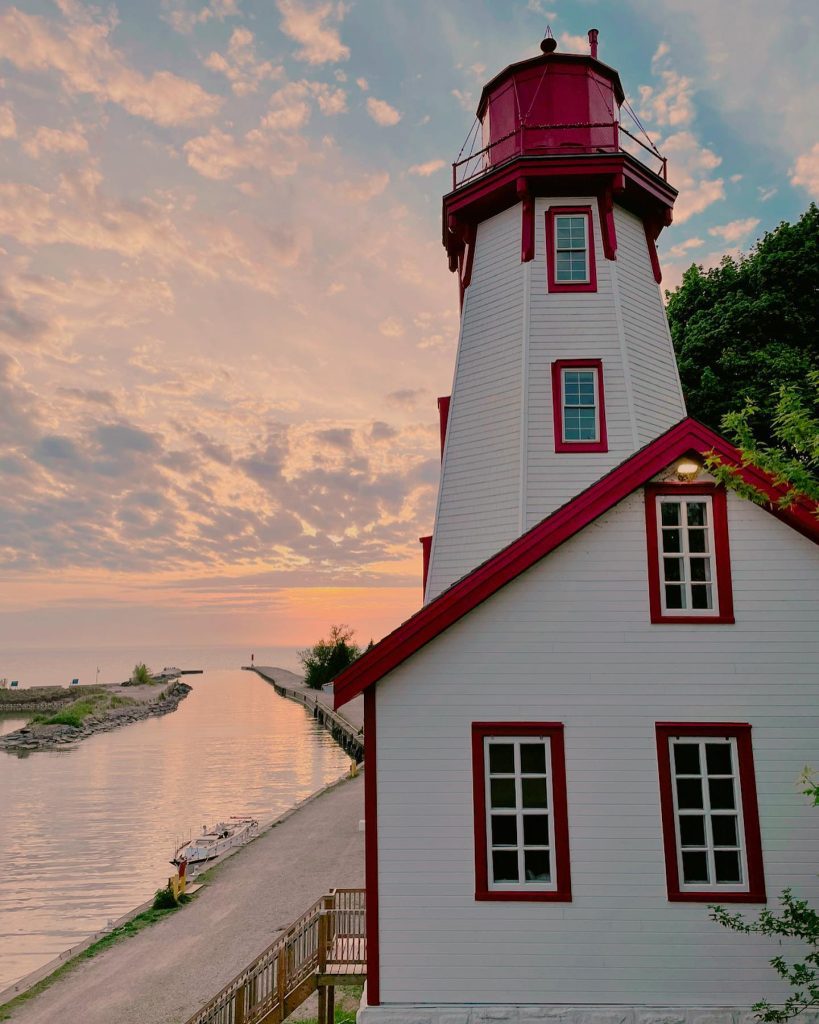
Constructed in 1880 along the bank of the Penetangore River, the Kincardine Lighthouse is the only lighthouse built in the core of a town. Kincardine had a bustling fishing and local salt shipping industry as well as supporting lumber and furniture companies that needed a safe port to ship their goods. It sits 24 metres tall (74 feet) atop the two-storey lighthouse keeper’s dwelling. Capped by an iron lantern and balcony, the Kincardine Lighthouse sports the familiar “lighthouse red” you see across a number of these structures.
The first lamp was fuelled by kerosene and featured shutters that were rotated by chains in order to make the light flash for vessels on the water. A little over 40 years later, the lamp was upgraded to be powered by electricity. Nowadays, the sector light located at the end of the north pier has taken the lighthouse’s place as the official navigation aid and the lighthouse transformed into the Kincardine Marine Museum. Open July 1st to Labour Day, stop in and learn more about the fascinating history of the Kincardine Lighthouse and the surrounding area.
Things to Do in Kincardine
The lighthouse and museum may be one of the top things to do in Kincardine, but the town certainly has much to offer! Spend some time enjoying the views of the Penetangore River at Rotary Park or dip your toes in Lake Huron at Station Beach. If catching some waves is on your Lake Huron lighthouse itinerary, you can rent a surfboard or stand-up paddleboard from SurfSup or sign up for one of their classes. You can also cast a line and see what bites by booking a fishing adventure with Dwindle’s Dream Fishing Charters!
Once you’ve had your fill of outdoor adventure, head into town and explore. There are a number of adorable shops and fantastic art galleries including The SeeView Gallery right on Queen Street. You might as well grab a coffee from The Daily Grind or a tasty cone from the Ice Cream Shack to enjoy as you wander! Or you can always grab a refreshing pint from the Grey Matter Beer Company. As for food, you’ll find a variety of stellar eats to satisfy your hunger. Fresh fish and chips with all the homemade fixings can be found at the Erie Belle. Enjoy spectacular waterfront views from The Bruce‘s patio to go with their steaks, salads, sandwiches and more. Of course, you can never go wrong with pizza and Huron Stone has plenty of great pies to enjoy.
Chantry Island Lighthouse

Chantry Island is located approximately two kilometres southwest of the Saugeen River on Lake Huron. Posing a threat to sailing ships, an impressive Imperial lighthouse was built in 1859 alongside the lightkeeper’s quarters and a boat house. Standing at 26 metres (86 feet) above water level, the lantern room was originally fitted with a Fresnel lens that was built and transported from Paris, France. Originally powered by sperm whale oil then later kerosene and finally electricity, the light is now powered by solar panels!
As the Chantry Island Lighthouse is indeed located on the island, access is only possible by booking a tour operated by the Marine Heritage Society. While some may be tempted to paddle out if they’re experienced enough, Chantry Island was designated a Federal Migratory Bird Sanctuary in 1957 in order to protect the migratory and nesting birds that visit the island. As such, the number of people allowed to visit the island on any given day is limited which is why tours must be booked. However, it’s possible to see colonies of Great Blue Herons, Great Egrets, Herring Gulls, Mallards, Northern Pintails and many more bird species depending on when you visit!
Southampton Range Lights
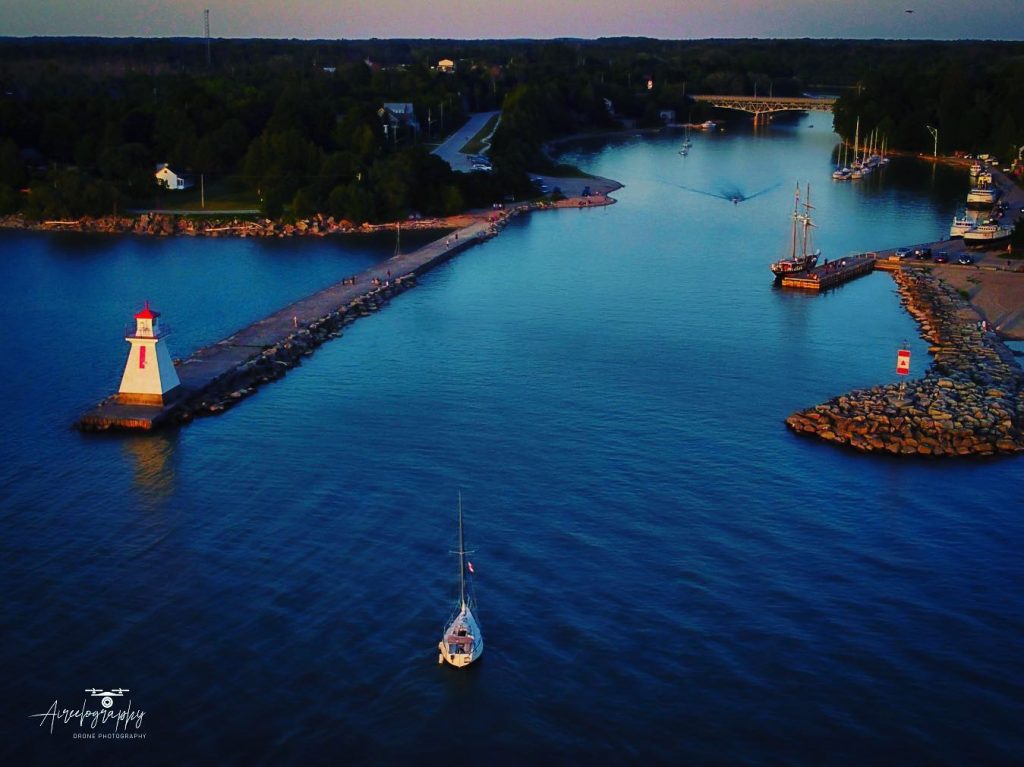
While the Chantry Island Lighthouse warns ships of the dangers in the surrounding waters, smaller range lights were built in 1903 on the Saugeen River. Their purpose is to aid sailors in lining up their ships for entering the harbour and therefore, staying on course until the river channel. However back in the late 1800s, the front and back range lights were lanterns hoisted on tall masts. They were later replaced by square wooden buildings that are now electrically powered. An automated foghorn at one point bellowed its warning call whenever the fog rolled in, but it has been replaced by audio signals that boaters tune into on their marine radios.
Things to Do in Saugeen Shores
The McNab Point and Chantry Island Lighthouses as well as the Southampton range lights can all be visited in a short time frame. It’s just a short 10 minute drive from the McNab Point Lighthouse to the Southampton front range light which you can coordinate to experience either before or after your boat tour to Chantry Island. Don’t forget to pop by the Bruce County Museum & Cultural Centre to check out the historic Stokes Bay range light!
Saugeen Shores encompasses both Port Elgin and Southampton so there’s no shortage of things to see and do. Don’t miss checking out some local works in Southampton at Light House Photo Gallery and Southampton Arts Centre. The family-owned Southampton Market features two floors of everything you could imagine including linens, tools, paintings and even Mennonite furniture. You never know what unique goodies you’ll find at the local shops including The Wildflower Company and Casual Corners in Port Elgin as well as at Re:mind Wellness and Logan’s in Southampton. Of course, you can always treat yourself to some beer as a souvenir and stop by some of Bruce County’s craft breweries with one in each town!
There are plenty of hiking trails including those at MacGregor Point Provincial Park and the Saugeen Bluffs Conservation Area. Dig your toes in the sand at Port Elgin, Chantry and Southampton beaches as you catch a brilliant Lake Huron sunset. All that exploring is guaranteed to make you hungry so grab a table at one of the fantastic local restaurants. Rabbit Dash Coffee House and The Wismer House in Port Elgin as well as The Lighthouse Restaurant and the Highview Food & Drink in Southampton are all great recommendations for local fare.
Cape Croker Lighthouse
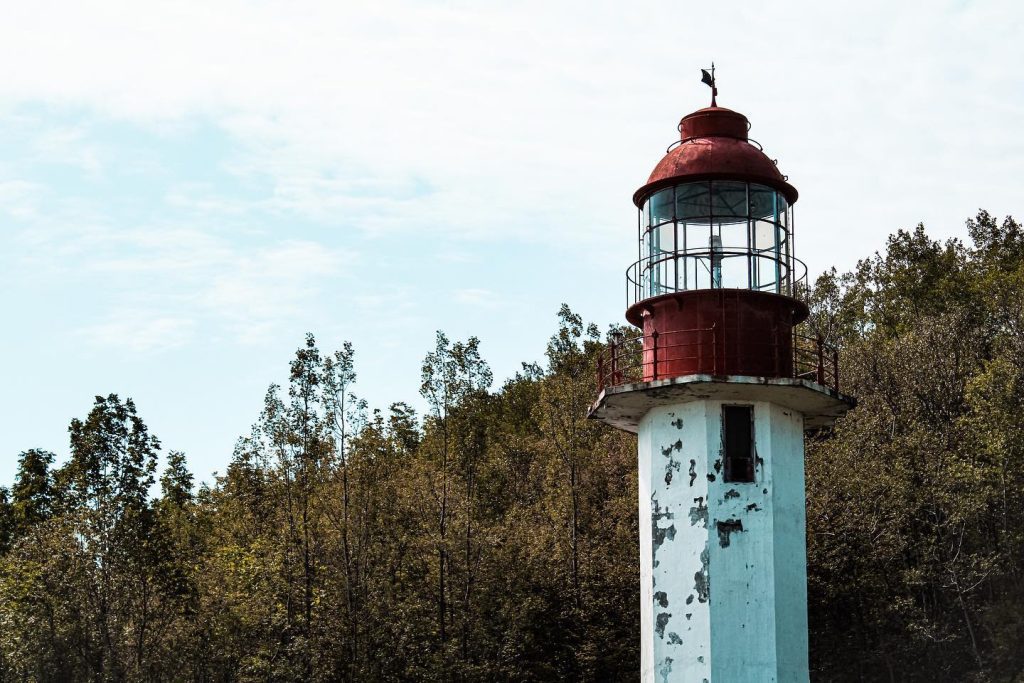
The Cape Croker Lighthouse was first established in 1898 in Neyaashiinigmiing meaning “at/by the point-of-land portage” in Ojibway. Originally a wooden structure, it was quickly replaced just four years later with the present, stronger octagonal lighthouse. The Cape Croker Lighthouse stands 18 metres (53 feet) tall and features a Fresnel lens that can cast light 24 kilometres (15 miles) into the waters of Georgian Bay. It was not only the first of its kind but the Cape Croker Lighthouse was also the first to feature an electrically operated light and foghorn!
However, this site sure looked different then compared to today. There was once a 5-bedroom home where the lightkeeper lived along with his family. It was demolished in 1975 so all that remains is the concrete light tower as The Cape Croker Lighthouse has been unmanned since 1986. Later in 2007, the Coast Guard removed the Fresnel lens as there was a concern of vandalism and in 2009, it found a new home at the Bruce County Museum & Cultural Centre.
Things to Do Near Cape Croker
One of the big draws to this area is all of the fantastic opportunities to hike the Bruce Trail. The Sydney Bluff features the Ladder Trail where this out-and-back hike ends with a steel staircase climb to incredible views of Georgian Bay. Jackson’s Cove is a 2 kilometre Bruce Side Trail that takes you through a variety of terrain. Another great option for those really looking for a challenge is the Jones Bluff Loop. At 8.5 kilometres long, pack some snacks and plenty of water as it’ll make for a 3-4 hour long adventure!
After all that exploring, there’s a chance you’ll be hungry so head into downtown Wiarton for some great eats like the ones you’ll find at Dockside Willie’s and the Green Door Cafe. You’ll also find a number of adorable shops like the Handicraft House Trading Post and Symon Says. Don’t forget to pop into Bluewater Park and say hello to Wiarton Willie himself!
Knife Island Lighthouse
Originally built in 1885, the Knife Island Lighthouse was a 16 metre (50 foot) wooden structure erected on the western shore of Lyal Island as a way to protect incoming marine voyagers. Almost 75 years later, it was replaced by the steel navigational tower you see today and the light was automated in 1959.
The Knife Island Lighthouse is the last standing of a three-lighthouse cluster. Knife Island acted as the front range light while the Irish Harbour Lighthouse (which has been demolished) was the rear range light for Stokes Bay. The final lighthouse and main light station on Lyal Island caught fire and burned to the ground in the 1960s.
Similar to Chantry Island, the Knife Island Lighthouse can only be accessed by boat. Unfortunately, there are no public tours that operate to visit it so you will need access to your own vessel. You can canoe or kayak out to the lighthouse but this is recommended for experienced paddlers only.
Things to Do Near Knife Island
If you’re an avid cyclist, you’ll want to make sure you pop by the Lindsay Tract Trails. The largest of the county forests at over 8000 acres, it offers a number of routes that are fantastic for mountain biking as well as hiking.
At the junction of Highway 6 and County Road 9, you’ll find the quaint town of Ferndale. The Bear Tracks Inn is the main highlight and is a great spot to rest your head for a quieter alternative to Tobermory. It also has a restaurant featuring home-cooked eats that are reasonably priced to keep you fuelled as you explore Bruce County.
Lion’s Head Lighthouse
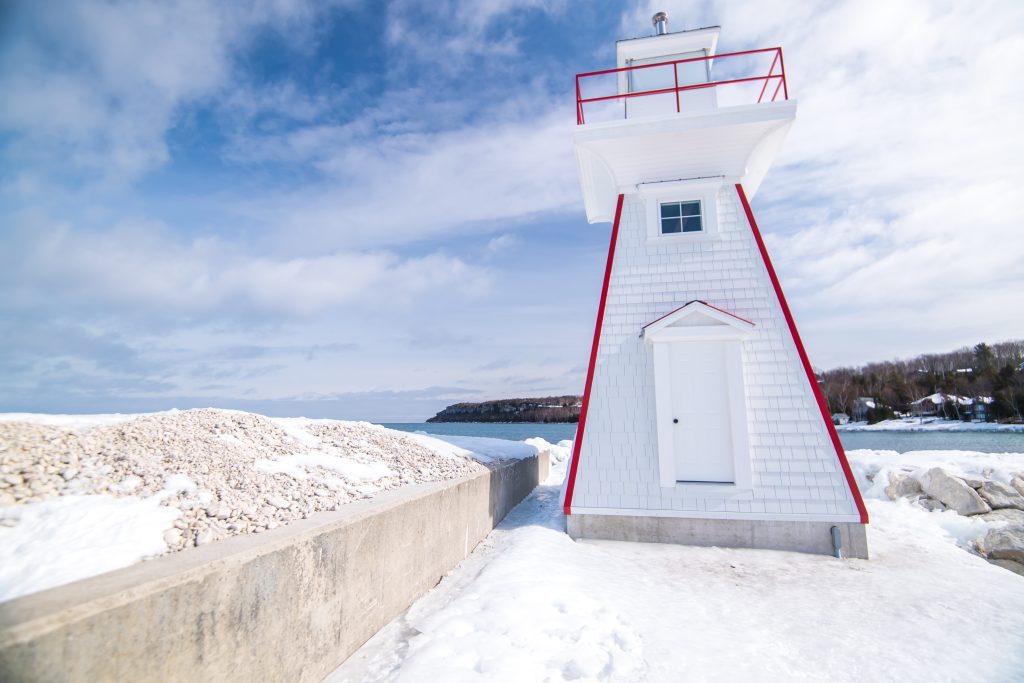
What was originally just a tubular lantern hoisted on a pole in 1903 has since become an icon along the eastern shore of the Bruce Peninsula. Ten years later, a pyramidal tower was constructed on the breakwater but the gale force winds of Georgian Bay blew the Lion’s Head Lighthouse into the water shortly after. However, it was recovered and restored to its current position on the pier.
That was not the last misfortune this poor lighthouse would be subjected to. You might be surprised to hear though that in 1933, it wasn’t wind or fire but rather the Canadian Coast Guard that were the lighthouse’s next opponent as they dismantled the tower in 1969 to replace it with a characterless flashlight atop a metal tower. The locals were furious that their cherished lighthouse was no longer, but students at the Bruce Peninsula District School took matters into their own hands and with support from the Lion’s Head Rotary club, constructed a replica using the original plans in 1983. It didn’t replace the metal light tower on the breakwater but it sat beautifully on the shoreline nearby.
Then came the year 2000 when an aggressive storm damaged the metal pole and the Coast Guard replaced it with the student-built replica. Lion’s Head once again had its iconic lighthouse. Twenty years later, yet another Georgian Bay storm had plans for the Lion’s Head Lighthouse as it was swept off its foundation and mangled into a number of pieces. For a second time, the community came together to rebuild it and in September of that same year, the lighthouse was erected once more. However, it was shifted approximately 20 feet back from its original location, with the hopes of keeping it safe from any future storms.
Things to Do in Lion’s Head
While the town of Lion’s Head is best known for its iconic lighthouse, it has become a popular destination on the Bruce Peninsula over the past decade. Named after the lion’s face you can see in the Niagara Escarpment, the Bruce Trail runs atop it through Lion’s Head Provincial Park which is a big draw for the area. These are some of the best views in the area so it’s understandable why so many want to hike it! Make sure to book your parking in advance.
The town is easily walkable and the perfect way to spend a morning or afternoon exploring at your leisure. See what goodies you’ll find from the local businesses at The Shops at 84 Main. If you’re a paddler, bring your canoe or kayak as Lion’s Head Beach is a great launch spot so you can enjoy the brilliant turquoise waters of the area. Of course, you can always stay on land and lounge in the sun. When hunger strikes, the Lion’s Head Pub, Taste Kitchen and Rachel’s Restaurant all have great eats to fill your rumbling stomach.
Lion’s Head also makes a fantastic home base to explore more of the Northern Bruce Peninsula. This truly is a hiker’s paradise with an abundance of trails just waiting to be explored. Just south of town, explore the magnificent outcrops of the Greig’s Cave system. Head directly across to the western side of the peninsula to check out Black Creek Provincial Park. Hop onto Highway 6 and head north where cyclists will love the Lindsay Tract Trails as it boasts a variety of routes for all skill levels. Continue on for more stellar hikes along Dyer’s Bay to the Devil’s Monument and to your next stop on this Lake Huron lighthouse adventure.
Cabot Head Lighthouse
For many years, there were no beacons to signify the treacherous shoreline of the Bruce Peninsula between Lion’s Head and the entrance to Georgian Bay at Cove Island. This began to pose a problem as marine traffic increased in the ports of Owen Sound, Collingwood and Midland by the 1890s. In 1895, the Department of Marine and Fisheries called for the construction of a lighthouse and fog station at Cabot Head to rectify this and the Cabot Head Lighthouse began warning sailors of its shores in 1896. Many years and light keepers later, a separate residence was constructed in 1958 for the keeper with the light being transferred to a skeletal tower when electricity reached the station in 1971. The Cabot Head Lighthouse then became automated almost two decades later in 1988.
The lighthouse sat empty for five years until a group of local, concerned citizens banded together to create the Friends of Cabot Head. They agreed to restore, manage and maintain the property, receiving a lease for the lighthouse in 1993. While there was once a gift shop and museum, it’s currently not accessible to the public. Unfortunately, the Friends of Cabot Head no longer has a lease and so ownership and operation of the lighthouse are in limbo but even though there’s hope for it to reopen once again, washouts along the road will stop you dead in your tracks. For now, the Cabot Head Lighthouse can only be seen from the water.
Big Tub Lighthouse

With the purchase of land on the western side of the entrance to Tobermory Harbour by the Department of Marine in 1885, Big Tub Lighthouse was constructed. This hexagonal wood building sits just over 13 metres (41 feet) tall and is visible almost 13 kilometres (8 miles) from all directions. Unlike many of the lighthouses in Bruce County, Big Tub’s history is fairly quiet in that at one point the original structure needed to be replaced and it was eventually automated in 1952. The history of its keepers, however, that’s quite the tale!
With a lack of infrastructure and little salary, four of the seven keepers were dismissed due to slacking on the job and another mysteriously disappeared. It was only the final two keepers, John H. Smith and Thomas Andrew Hopkins, who prided themselves on their work that stuck out their commitment. Smith only resigned due to old age and the position being terminated ended Hopkins’ term.
Much later in 1985, the Friends of Fathom Five established a pathway and viewing area so locals and visitors could better enjoy the lighthouse. While it has needed some repair from time to time after facing some stormy weather, Big Tub Lighthouse stands to this day as it guides vessels like the iconic Chi Cheemaun into Tobermory Harbour.
Things to Do in Tobermory
Rich with marine heritage, Tobermory has exploded in popularity over the past few decades. This quaint harbour town is a hot spot for fun in the summer months! Stroll around town and check out the quaint shop bursting with unique merchandise inspired by the Bruce Peninsula and the Great Lakes as well as the work of local artisans. Feast on fresh whitefish caught in the surrounding waters at restaurants like Shipwreck Lee’s and the Crowsnest Pub. Wash it down with a pint at Bruce County’s first craft brewery, Tobermory Brewing Company.
It’s no secret that the area is bursting with natural beauty which is why hiking and camping are two big draws to the area. Bruce Peninsula National Park is home to iconic sites like the Tobermory Grotto and Indian Head Cove. The Bruce Trail runs right through this UNESCO world heritage site as it heads towards its Northern Terminus in the heart of town. You’ll also find the Fathom Five Marine Park Visitors Centre with trails that lead out to Little Dunks Bay. Climb the lookout tower for some spectacular views of the area!
Over two dozen ships have met their demise because of the rocky waters surrounding Tobermory, making it the hub of scuba diving in the Great Lakes. Divers Den runs both open water and advanced charters so you can see wrecks like the Wetmore and Sweepstakes. Snorkelling and kayaking are also two popular activities to get a glimpse of these stunning sites. The most popular way to see them is via boat charter as they take you around the shores of Tobermory while making your way to Flowerpot Island.
Flowerpot Island Lighthouse
Perched atop Castle Bluff, the original Flowerpot Island Lighthouse was built in the autumn of 1897. It was a square wooden structure with the lantern rising from the roof’s apex. At just 9 metres tall (30 feet), it was fairly quaint but the added elevation of the bluff allows its light to beam from almost 27 metres (88 feet) above the water. The two-storey lighthouse keeper’s quarters was built a few years later in 1900 with a second dwelling built for the assistant keeper in 1959 who up until this point had been living in the lighthouse itself!
With advancements in technology allowing for automation, a pyramid-shaped steel tower was established in 1968 and just one year later, the old lighthouse was burned and pushed over the cliff as it was no longer needed. Almost two decades later in 1987, the lighthouse was de-staffed and sitting vacant. Concerned about the deterioration of the other buildings, the Canadian Coast Guard came to an agreement with the Friends of Fathom Five and gave them the reigns in 1996. Restoration work began a year later.
Now known as Friends of the Bruce District Parks Association, it’s thanks to their volunteer efforts and partners that the Flowerpot Island Lightstation is in such great condition. Some of the work includes new steel roofs, gardens being established and development of museum displays. In 1998, they began the Volunteer Lightkeeper Host Program where members are allowed to live at the site for several days at a time!
Things to Do on Flowerpot Island
As a small part of the Fathom Five National Marine Park, Flowerpot Island remains mainly undeveloped to protect the natural wonders found here. Trails have been established that allow you to explore the island and see the iconic rock formations the island is named after. There are also some caves towards the interior of the island that Parks Canada has built elevated platforms so visitors can peek inside.
If you want to have Flowerpot Island (almost) all to yourself, consider booking a campsite and staying overnight! There are six backcountry campsites where you can pitch your tent and enjoy the sights and sounds of the island without the gaggles of people. It’s a fantastic destination for stargazing and the views at sunrise are spectacular. Just remember that you need to pack everything in and out so be prepared to lug everything you need on and off the boat!
Cove Island Lighthouse
The first of the six Imperial-style lighthouses to be built, Cove Island Lighthouse has been helping sailors safely navigate the straight between Georgian Bay and Lake Huron since 1858. Sitting on the northeast tip of the island at Gig Point, it stands just over 24 metres tall (80 feet) and is constructed of white limestone extracted from the very same island it stands on. It’s accompanied by the dwelling that the lightkeeper stayed in as well as a foghorn building. The current foghorn building is the second to be built as the original was destroyed by fire, though it contains the last intact diaphone foghorn on the Great Lakes.
One of the last operating lighthouses in Bruce County, it became automated and the final lightkeeper left in 1991. It’s still in operation to this day by the Canadian Coast Guard with its original Fresnel lens flashing white every five seconds. You cannot visit the lighthouse or the island but you can see it from the water when taking the Chi Cheemaun between Tobermory and Manitoulin Island as well as on boat tours of the area.
Lake Huron Lighthouses: A 3-Day Itinerary
Spanning from Point Clark in the south all the way up the Lake Huron shoreline to Tobermory and back down Georgian Bay to Neyaashiinigmiing, our shoreline has more than our fair share of these gems. Not sure how to tackle them all in one trip? Here’s a fantastic three-day itinerary to help plan your unique Lake Huron lighthouse tour in Bruce County!
You’ll want to limit your driving to around 2-2.5 hours each day so you have time to explore and enjoy what each of these towns in Bruce County have to offer. We recommend splitting them up:
- Day 1 – Point Clark, Kincardine, McNab, Southampton and Chantry Island
- Day 2 – Cape Croker, Lion’s Head, Knife Island
- Day 3 – Big Tub, Flowerpot Island and Cove Island
While this itinerary runs from south to north, you can always do the reverse if that fits your schedule better. Of course, if time only permits for so many stops then pick and choose your favourites from the recommendations listed. The most important part is enjoying the journey as you experience all the lighthouses Bruce County has to offer!

